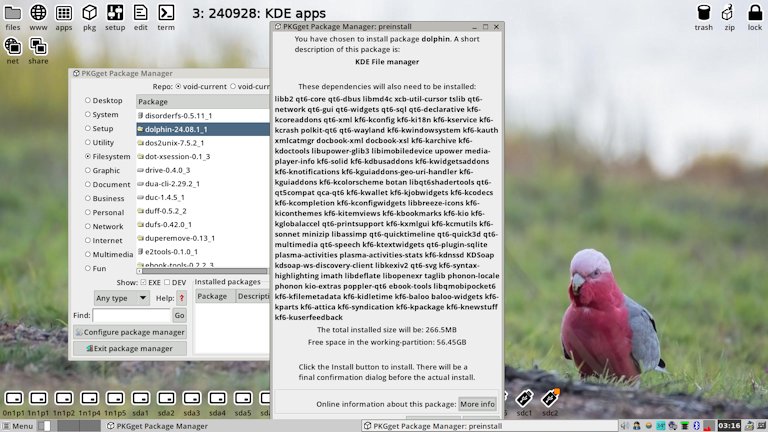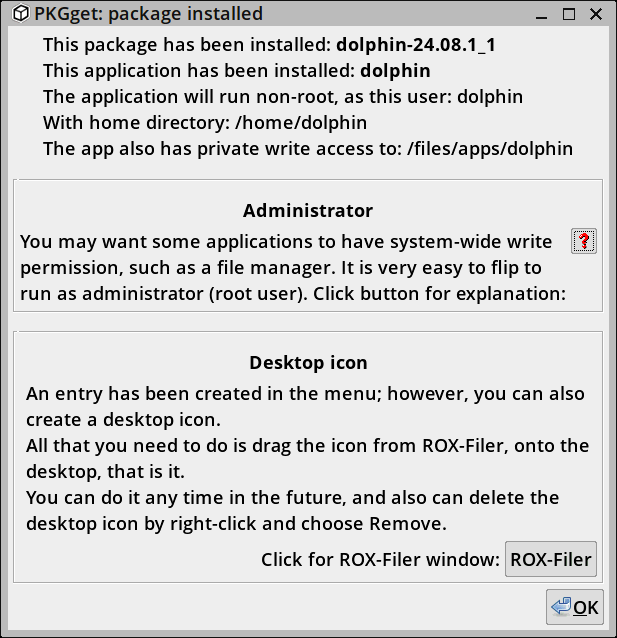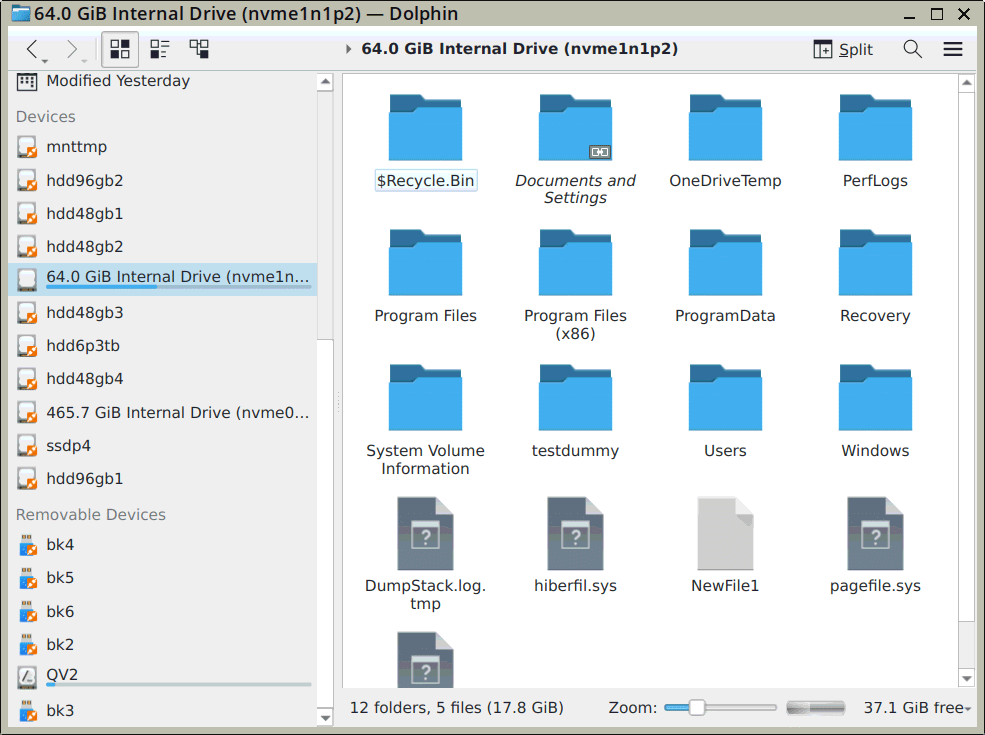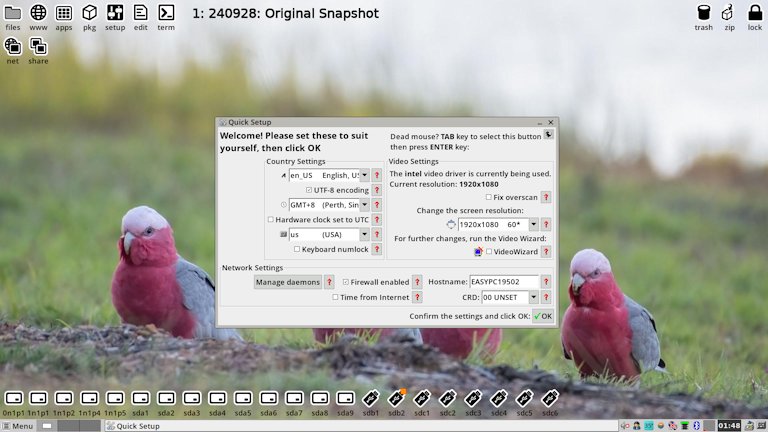KDE Dolphin works in QV
It is almost 4am, should be in bed, but couldn't resist doing this...
Posted a few hours ago success booting up QV:
- The pink and grey galahs have returned! — September 28, 2024
So booted and created a new snapshot, titled "KDE apps", then installed Dolphin file manager:

...93 dependencies, the download was about 70MB. No problem, they installed, then:

Dragged a desktop icon, but ran "dolphin" from a terminal to see if any error messages. Works, but when clicked on a partition:

Dolphin has installed to run as user "dolphin". So, instead run "dolphin.bin" in the terminal, to run as root, now mounting a partition works:

...good. But the problem with polkit is something that we were tackling before, and will need to look at it again.
A question has arisen; it would be nice if we can flip snapshots
on-the-fly, without having to reboot. Possible? Will think about
it.
Tags: quirky
The pink and grey galahs have returned!
I posted a couple of days ago about compiling the 6.6.52 kernel:
- Kernel 6.6.52 compiled — September 25, 2024
But then built QV and discovered that btrfs support is a module. Require it builtin, and want to enable kexec, so have recompiled 6.6.52 with these:
CONFIG_BTRFS_FS=y
CONFIG_KEXEC=y
The reason for that last one is that the menu in the initrd has
an item to run the Xorg Wizard if the video is broken. That
requires the "nomodeset" kernel command-line option. The initrd
has the 'kexec' utility, which can restart the kernel with a new
set of command-line parameters.
Did a quick test, the kexec thing flashed up an error message, then booted as normal. So, that needs to be fixed.
It is nice to be running QV again. The birds are back:
Tested a few things; all working so far. Some items on the to-do
list, hope to be able to upload QV soon.
Tags: quirky
EasyOS ports to QV
EasyOS is built with woofQ, QV with woof-quantum-vis (which could be called woofQV). For the last 4 months I have been working on the Scarthgap-series of EasyOS; that is, working on woofQ.
A lot of improvements and fixes have gone into woofQ, that I have spent the last couple of days porting over to woofQV.
Had to do it the hard way, manually, as although the two build systems have a lot in common, they have major structural differences. WoofQV has been an attempt to rationalize and simplify, and get rid of a lot of historical baggage, that is in woofQ.
Anyway, here are the recent commits to woofQV:
https://github.com/bkauler/woof-quantum-vis/commits/874189fb988d251407fae1fcd6f3ab29f0f83ef7/
Need to put some thought into streamlining syncing of changes
between woofQ and woofQV.
Need to check a few more things, then might have a go at doing a
build.
Tags: quirky
ibiblio.org quirky repository cleaned out
I warned about this on the forum, about 5 months ago:
https://forum.puppylinux.com/viewtopic.php?t=11326
It hosted some old pups, especially Wary and Racy, and Quirky Linux. The repository is mentioned in various posts on the forum, such as this in 2021:
https://forum.puppylinux.com/viewtopic.php?t=2678
Here is the quirky repo:
https://distro.ibiblio.org/quirky/
The site is now home for "Quirky Void", also known as "Quantum
Vis", or just "QV". The ibiblio site will have releases and PET
packages.
The woof build system for QV is on github:
https://github.com/bkauler/woof-quantum-vis
A technical detail about mirroring from ibiblio.org, including puppylinux, easyos, quirky and fatdog; the server name has changed. Only in the last month. It used to be:
rsync distro.ibiblio.org::quirky
Now requires:
rsync rsync.ibiblio.org::quirky
I see that NLUUG still has the old stuff:
https://ftp.nluug.nl/os/Linux/distr/quirky/
I sent an email to my contact at NLUUG informing about the change
for easyos, and that got fixed, but quirky hasn't yet -- will have
to send an email about that also. Will do that soon; grab anything
off there if you want.
Tags: quirky
QV version 240506 pre-alpha released
This is basically the same as the previous release, 240425:
https://bkhome.org/news/202404/qv-version-240425-pre-alpha-released.html
Except have reverted the pam/shadow change, as it caused some
breakage, reported by Caramel:
https://forum.puppylinux.com/viewtopic.php?p=117978#p117978
Download from here:
http://distro.ibiblio.org/easyos/amd64/releases/void/
Note, as I am typing this blog post, 'qv-240506-amd64.img' is
still uploading. The Internet connection has become very slow.
Tags: quirky
QV version 240425 pre-alpha released
See 240423 announcement:
https://bkhome.org/news/202404/qv-version-20240423-pre-alpha-released.html
I was hoping to get onto implementing an update mechanism, but we keep finding bugs.
Download:
https://distro.ibiblio.org/easyos/amd64/releases/void/
One change made, and I have my fingers crossed that it is ok, is
have now included the Void 'shadow' package. I had previously told
XBPS to ignore 'shadow' if it is a dependency of any package, as
it requires 'pam'.
'pam' causes trouble, but I think now have managed to disable it. We want the 'shadow' pkg, as any package that wants to create entries in /etc/passwd (etc.) needs it.
Forum discussion welcome here:
https://forum.puppylinux.com/viewtopic.php?p=117896#p117896
...first post in that thread explains about 'qv-installer', for
direct install to internal drive.
I did some basic testing of 240425, very basic. Installed the
'devx' PET via PKGget, and it worked ok, took awhile. At the end
PKGget reported a lot of missing dependencies still not installed.
I don't know what to make of that, as XBPS did the installing, and
it would have installed all required deps. So probably PKGget has
got it wrong.
Tags: quirky
QV readme on github
The readme file on github was previously empty. I have inserted a basic explanation about QV:
https://github.com/bkauler/woof-quantum-vis
Tags: quirky
Fix bluetoothd endless restarting
In 2020 I posted about using the 'restarter' utility in /etc/init.d/bluetooth, to immediately restart 'bluetoothd' if it crashes:
https://bkhome.org/news/202011/xf86-input-wacom-and-restarter-compiled-in-oe.html
Yes, well, the worst has happened. Testing the latest QV, I observed /tmp/bootsysinit.log being endlessly appended, like this:
...
restarter[8300]: Executing [79]: (/usr/sbin/bluetoothd)
restarter[8604]: Starting [/usr/sbin/bluetoothd] with pid:8604
D-Bus setup failed: Name already in use
restarter[8603]: [8603]:sigchildhdl_GetExitStatus SIGCHLD handler, child_pid:8604, waitpid returned:8604, exit_reason:process exited, exit status=1, child exit status:256, signal:17, nchildren now:0
exit_valid:(), cmd_exitstatus2:1
[8603]: Exiting
restarter[8300]: Executing [80]: (/usr/sbin/bluetoothd)
restarter[8606]: Starting [/usr/sbin/bluetoothd] with pid:8606
D-Bus setup failed: Name already in use
restarter[8605]: [8605]:sigchildhdl_GetExitStatus SIGCHLD handler, child_pid:8606, waitpid returned:8606, exit_reason:process exited, exit status=1, child exit status:256, signal:17, nchildren now:0
exit_valid:(), cmd_exitstatus2:1
[8605]: Exiting
...
I do not know of a fix for this. 'bluetoothd' is still flakey and can crash. Just restarting it causes that dbus problem and it immediately crashes. I didn't have this problem with EasyOS, or perhaps I just didn't notice it.
So, have taken out 'restarter':
https://github.com/bkauler/woof-quantum-vis/commit/ac472ff697184ffaf3d48e6c6ff432b8d03f0577
However, 'restarter' does work, at least sometimes, without going into that endless loop. Now, if it crashes, that's it, you will have to manually restart it, by "/etc/init.d/bluetoothd start" -- and I hope that it doesn't hit that dbus problem.
It would be good if 'restarter' could set a limit on how many
restarts. Oh, and it is not just a QV problem; do a search on
"bluetoothd d-bus setup failed: name already in use" will return a
lot of hits.
Tags: quirky

